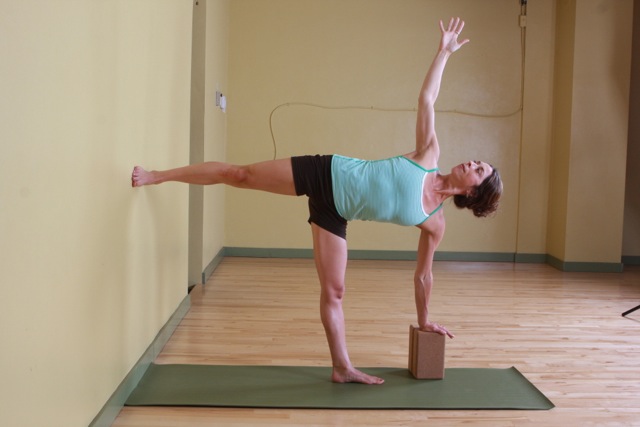Make Your Own Luck in Half Moon Pose
March Pose of the Month: Half Moon
Balancing poses like ardha chandrasana (Half Moon pose) teach us how to make our own luck. The first zillion times we practice Half Moon, our chances of steadily holding the pose are akin to rolling dice. Sometimes we get lucky and nail it, but a lot of times we fall out. It’s a lesson we all have to learn: some days you will struggle, and other days it will seem like things just effortlessly flow your way.
The word chandra in Sanskrit means moon. Christine Joseph, PFY’s Director of Teachers and Education, believes we make our own luck according to the moon’s cycle. “During the new moon, we are encouraged to set new intentions and focus on what we really want in life,” says Joseph. “Then, during the remaining phase of the moon, we cast out to the Universe our intentions.” Focus on your goals, she says, but then have faith you’ll eventually attract that which you seek. (I can hear my future husband slowly making his way into my life as I write.)
The next time you practice Half Moon, try to slow down. Stay focused on what’s really important: your breath, your integrity, your mental state, etc. When you decelerate your yoga practice, you become the witness to your experience. You become more embodied, present and focused. Here’s five tips to make your own luck in Half Moon.
 Focus on your standing leg
Focus on your standing leg
When it comes to balancing poses, we always forget about the bottom leg. Please, I AM BEGGING YOU, focus on your standing foot in ardha chandrasana. Don’t rush the setup. Ground down through your heel and your big and pinky toes, and gently squeeze them toward each other to lift your foot’s three arches. Make sure your toes and kneecap face forward the whole time. If your toes start to turn in, it’s often to compensate for weak muscles surrounding your hip joint.
You have to stay focused in balancing poses and in life. You can live your life based on luck, divine intervention, maybe even some hocus pocus. Or you can hunker down and sharpen your focus on what it is you actually want. Sure, lightning strikes, but it all comes down to you in the end.
Slow and steady
When trying to make your own luck, you will often get ahead of yourself. As humans, we’re naturally impatient. So we either give up way too early or burnout because we’re too intense coming out of the gate. Slow down, and perhaps you’ll illuminate new perspective.
You can have the same experience in Half Moon. Once you’ve set up your standing leg, invite your breath back into your practice. Your breath will slow you down, so you can focus on what’s happening in your body. It’s tempting to use momentum to catipult forward in Half Moon, but you’ll find it easier to balance if you pump your breaks a bit. Slowly lean forward as you drag your back leg in and up into the pose.
Open from the bottom hip, not the top
Since we usually forget about the standing leg in ardha chandrasana, we also focus too much on the top leg. While most people understand the bottom thighbone externally rotates in Half Moon (it’s the same as Warrior 2 or Side Angle), there’s much confusion regarding the top leg. In order to maintain the integrity of your standing leg, you’ll likely find that your top leg needs to internally rotate.
Generally speaking, in regards to standing poses, both thighs externally rotate (toes turned out) only in poses like malasana (Squat pose) or utkata konasana (Goddess pose) or their variations. Many students often swing their top leg behind the hip when trying to externally rotate the thigh. “Don’t try to stack the hips,” adds 200-hour teacher trainer, Carrie Parker. “Actually internally rotate the top leg lifting the heel higher than the toes.”
 Activate your lifted leg
Activate your lifted leg
You need to press strongly through the heel of your top foot. Gravity will bog you down in Half Moon making it hard to activate your lifted leg. But the more you reach through your top leg and arm, the lighter the pose becomes.
If you’re not quite sure how to engage your lifted leg, try pressing your heel into a wall the next time you practice Half Moon. The wall gives you something to press into, and voila! A brand new way to experience Half Moon.
Use a block
This one’s cut and dry: use a block in Half Moon. Your arm is not as long as your leg. If it was, you’d be an orangutang. Using a block under your hand levels the playing field. Note that using a block does not mean you are weak, inflexible, unloved or basic.
When a yoga student uses props, it demonstrates a certain maturity in their practice. Students who use props are likely less concerned with the way their practice looks on the outside and are more interested in how it feels on the inside. People who make their own luck understand that you can only control what’s going on inside you.
Focus, but hold on loosely
At the end of the day, balancing poses like ardha chandrasana will help you manage your frustration and fears. Fear is probably the biggest obstacle to making your own luck. The fear you’ll be rejected or ridiculed or criticized or that somebody else is already doing your thing better. Don’t worry about all of that. Just focus on the life you want to live, but let go of the outcomes.
“Measure your worth by your commitment, not your successes or failures.”
-Elizabeth Gilbert
